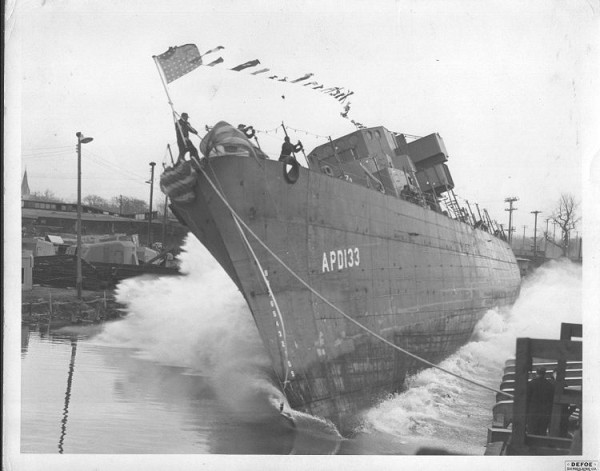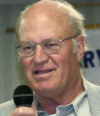| Home | Community | Arts/Theater | Business | Schools | Government | Downtown |
| Local News | Opinion | Health/Fitness | Events | Groups & Non-Profits | ||

The USS Burdo was a high speed transport launched at Defoe Shipbuilding in 1944. BAY CITY EXCEPTIONALISM: History Makers, Downtown Get High Grades
June 17, 2018
2 Comments
|
|||||||||||||||||
| Printer Friendly Story View |
Almost everybody loves their hometown.
But I believe we in Bay City have more reasons to be proud, especially in the light of history. Crain's Detroit Business recently proclaimed: "Bay City and Saginaw back from the brink with resurgent downtowns." These onetime lumbering boomtowns again are in the headlines.
As the New World was being settled 400 years ago, the world knew little of this wilderness. That was 1618 when the Puritans were struggling for life in what became Massachusetts, Maryland and Virginia.
Our history didn't start until 200 years later when the Tromble brothers established fur trading posts here.
Successive waves of Paleo-Indians lived here in prehistoric times about 8,000 to 12,000 years ago. The Old Copper People, the Hopewell People, Moundbuilders and finally the Sauk Indians.
Burial mounds here, opened by James McCormick and other early settlers, contained skeletons of a tribe over 7 feet tall. The Adena People who lived 500 to 200 B.C. throughout the Midwest, some sources say, were 7 to 11 feet tall with gigantic skulls and jawbones. William Cullen Bryant described the mounds as the "vast uncovered sepulchers" of the Ohio River Valley, but if and when the Moundbuilders lived here is still an archaeological mystery requiring more research.
The Sauk Indians were massacred here by rival tribes at the start of the Beaver Wars in 1642. Twelve families of Sauks survived and merged with the Fox Indians in Illinois, becoming known as the Sac and Fox Tribe. Puzzled by the lack of knowledge locally about the Sauks, I sought them out on a trip to Oklahoma in 1980.
The oral history of the tribe states the Sauks originated in the Saginaw Valley, with the main village on the west side of the river. Few traces of Indians here still exist, notably the gravesite of Chief Ogemaw in Roosevelt Park and several graves of later Indians in Oak Ridge Cemetery.
The first white man to visit this area, Jesuit Father Henri Nouvel, passed by here on the river on a 22-day canoe trip from the Straits in a freezing November of 1675. He spent the winter with the Indians camped near what is now the Tridge in Midland. Father Nouvel's reports to France in the Jesuit Relations mentioned scrub trees along the shore of Lake Huron; in 200 years those scrub trees became magnificent pine, oak and tamarack forests fueling the timber boom, 1850 to 1885.
In the War of 1812, 400 Ojibway braves who lived in villages here fought with the British against the United States; on the other side was Capt. Joseph Marsac, a Bay City native of Hamtramck. Most of the Ojibways were killed.
In what is now Wenonah Park stood the original Saginaw Bay Company speculation village consisting of 3 log houses, a boarding house, bank and outbuildings built at 4th and Water in 1838 by investors, including the governor of Michigan. The developers were said to have paid John Riley, son of a Chippewa woman, $60,000 for the 240 acres where Bay City was located. The money was lost in the economic crash of 1837 to 1842, leading to the village being abandoned for five years. Historians later realized Riley's claim in the Saginaw Treaty of 1819 was never ratified by the U.S. Senate. Nevertheless, development here went ahead for a town first known as Lower Saginaw.
In 1885 Bay City was considered one of three fastest growing towns in the U.S., the others being Denver and Minneapolis. Bay City's population of 1,500 at the time of the Civil War climbed to 41,000 by the turn of the century.
After the merger of Bay City and West Bay City, the city ranked third in population in the state after Detroit and Grand Rapids. That was the reason why we rated a federal court and the area headquarters of the Masonic order at the Consistory. The group once had 4,500 members stretching from Flint to the Straits of Mackinac.
When the first man to run for President on an anti-slavery ticket, James G. Birney settled here in 1842, the stage was set for the founding of the Republican Party "Under the Oaks" in Jackson in 1854. While a resident of Bay City in 1844, Birney's 15,000 votes from abolitionists in New York snatched the Presidency away from Henry Clay and helped put James K. Polk in office. His campaigns for governor and his anti-slavery writing were instrumental in creating the political atmosphere that eventually coalesced into the abolitionist Republican Party and elected Abraham Lincoln in 1860 which precipitated the Civil War. That topic is addressed in my book: "Apostles of Equality: The Birneys, the Republicans, and the Civil War," published in 2011 by the MSU Press.
In 1897 two firms began operations to tap the huge salt basin underlying this area: 1) The North American Chemical Company of Liverpool England, located south of 41st Street on the river in Bay City and 2) The Dow Chemical Company in Midland. More questions: Did Herbert Dow start his company in Midland because a rival firm was already here? The plant here was acquired by Consumers Power, torn down in 1929 and the massive ruins of the British firm still remain on the site after nearly 90 years.
On another industrial front, why did the tight-fisted town fathers of Bay City turn down David Buick when he offered to move his factory here if they would raise $100,000 in 1908? A town with a reported 100 millionaires could have raised that much at the card table at the Shoppenagon Grotto at the Bay City Club on Center Ave.
The rumor persists that auto racer Louis Chevrolet put a factory here to more easily visit a girlfriend who lived in the Thumb. An apocryphal story - Maybe. What is undoubtedly true is that the Smith family sold the Michigan Pipe Works and the National Cycle Company to William Durant, president of the infant General Motors. However, when Durant offered GM stock instead of $125,000 cash, they took the matter to the Michigan Supreme Court. The rest of the story is the court forced the Smiths to take the stock, making the entire family rich beyond measure for generations.
Bay City was at the center of national political history again in 1912 when the Bull Moose Party of Teddy Roosevelt sprang from the state GOP convention at the Armory here. Gov. Chase Salmon Osborn had to call out the National Guard to quell the riots between the Progressive supporters of TR and the conservatives of William Howard Taft. Teddy's men went on to Chicago and sparked a nationwide uprising that split the GOP allowing Democrat Woodrow Wilson to become President.
Bay City Exceptionalism was evidenced in the person of Oscar Baker Senior, who lost his leg in a train accident at age 7 in 1897. Civil War surgeons Horace Tupper and Robert Ervin operated on his parents' kitchen table on Adams Street. He persevered, becoming a scholar, earned his law degree at the University of Michigan, working as an assistant to the lieutenant governor, establishing a highly successful law firm and fathering nine children. He headed the Michigan Freedman's Progress Commission in 1915, the 50th anniversary of the end of slavery. His son, James Weldon Baker became the first African American president of the Michigan Junior Chamber of Commerce.
The list of other exceptional Bay Cityans includes tugboat captain Ben Boutell, whose rafting system for logs from Canada extended the lumber boom by 10 years, Harry Defoe who went from the school principal to one of the nation's leading shipbuilders, constructing 170 warships for the Navy in World War II,
--Dr. Esson Gale, who saved the Chinese economy by running that country's salt administration and repaying a $25 million loan to European lenders,
--Carl Boehringer U.S. diplomat, who was interned in Tokyo when Col. Jimmy Doolittle's bombers struck after Pearl Harbor,
--Webb McKinley, foreign correspondent for the Associated Press whose 1972 book predicted the Mideast troubles of today,
--Garland Nevitt, Michigan's first Native American high school football coach,
--Warren Avis who started a car rental business at airports while rival Hertz failed to follow suit for 10 years,
--Jack Wirt, sand and gravel king whose Michigan Ash Company doubled the life of highways by mixing fly-ash and concrete, and
--Ed Jablonski, starting at his family's Polish newspaper, Sztandar Polski, here, who wrote biographies of George Gershwin and a dozen books on aircraft combat. He encouraged Kevin Cole, a Bay City pianist who became the leading interpreter of Gershwin's music. The Polish newspaper was read to cigar rollers at several cigar plants once located in the South End who employed many women of Polish heritage.
Dozens of other Bay Cityans have had their bite from the golden apple of success, too many to list here. But this brief review shows that we historians have a lot to write about that has never been documented.
###
| Printer Friendly Story View |

|
Prior Article
March 5, 2025 by: Stephen Kent St. Patricks Parade 2025 - IT's TIME |

|
Next Article
March 5, 2025 by: Stephen Kent St. Patricks Parade 2025 - IT's TIME |
"The BUZZ" - Read Feedback From Readers! |
|
tjtobin Says:
On June 18, 2018
at 08:55 AM
Very nice David! Tim |
|
wallsopp Says:
On June 19, 2018
at 09:51 AM
Dave
Just love your articles and they are so important for preserving our history. Please keep up the good work |
|
|

Dave Rogers |
|
|
|
Printer-Friendly Story View
0200 Nd: 10-30-2025 d 4 cpr 1
12/31/2020 P3v3-0200-Ad.cfm
SPONSORED LINKS
12/31/2020 drop ads P3v3-0200-Ad.cfm
